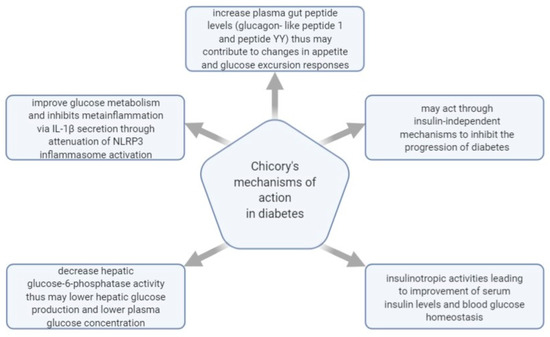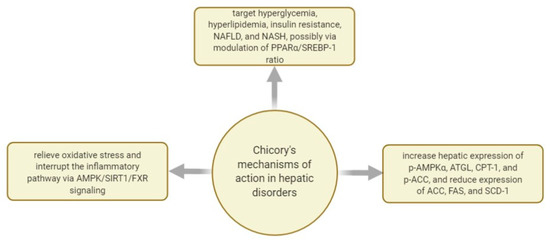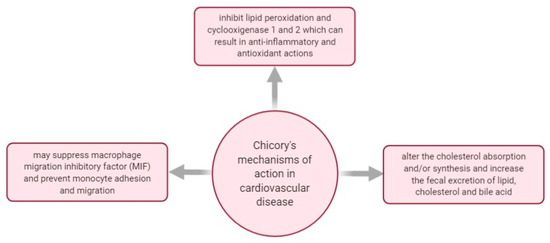Cichorium intybus L., commonly named chicory, is a perennial herbal plant of the dandelion family Asteraceae, mainly seen with bright blue flowers, and seldom pink or white. Generally distributed in Asia and Europe, all the plants’ parts were traditionally used in medicinal preparations due to their considerable contents of antioxidant phytochemicals thought to have a beneficial impact in preventing and treating various illnesses such as fever, diarrhea, jaundice, and gallstones. Different chicory types are grown for their salad leaves, chicons, or roots, and regularly used for inulin extraction, for preparing coffee substitutes, or for feeding livestock.
This entry is based on a literature review and highlights the beneficial and therapeutic action of chicory extracts and their confirmed or hypothesized mechanism of action in diabetes, hepatic disorders, and cardiovascular disease, as indicated by the results of in vivo and in vitro studies, on cell lines, human and animal models.
- diabetes
- hepatic disorders
- cardiovascular disease
- chicory
- cichorium intybus
1. Chicory Extracts and Their Natural Products Studied for Therapeutic Potential in Diabetes
C. intybus
Table 1 summarizes some of the later studies conducted to assess the chicory’s action in managing diabetes.
Table 17.
| Extract Type and Plant Part | Type of Study | Results | Responsible Functional Natural Products | References |
|---|---|---|---|---|
| Chicory seeds powder decoction | in vivo, in T2D patients (19 men and 11 women) | - decrease fasting and postprandial blood glucose | - caffeic acid, chlorogenic acid, chicoric acid | [1] |
| Chicory root fructans | in vivo, in normal, and obese diabetic and non-diabetic murine models | - modulate body weight, hyperglycemia, and hypercholesterolemia | - inulin-type fructans | [2] |
5].
Figure 1 shows some of the mechanisms of actions investigated regarding
C. intybus

Figure 17.
2. Chicory Extracts and Their Natural Products Studied for Therapeutic Potential in Hepatic Disorders
Table 2, there are some summaries of the studies conducted to assess the chicory’s action in managing hepatic disorders.
Table 28.
| Extract Type and Plant Part | Type of Study | Results | Responsible Functional Natural Products | References |
|---|---|---|---|---|
| Dried chicory root | in vivo, in growing swine models | - hepatoprotective action, potential therapeutic action in metabolic disorders | - inulin | [6] |
| Chicory seeds aqueous extract | in vivo, in diabetes, and oleic acid-induced NAFLD and NASH | - alleviate hyperglycemia, reduce lipidemic content, modulate insulin resistance, alleviate NAFLD and NASH | - caffeic acid, chlorogenic acid, and chicoric acid | [7 |
| Chicory seeds aqueous extract | in vivo, in murine diabetes models | - inhibit the progression of diabetes | - unspecified antioxidant compounds | [3] |
| Chicory leaves hydroethanolic extract | in vivo, in nicotinamide-STZ–induced diabetes in mice | - anti-hyperglycemic action, improve serum insulin levels | - lactucin | [4] |
| Chicory leaves methanolic extract | in vivo, in high-fat-diet-induced diabetes in mice | - enhance glucose metabolism and impede meta-inflammation | - sesquiterpene lactones (lactucin) | [5] |
[2].
[3].
C. intybus
Cichorium intybus
Cassia acutifolia
Salix aegyptica
Eucalyptus globulus
[4].
[1]
[
| ] | ||||
| Chicory root fractions | in vivo, in high-fat-induced NAFLD murine models | - alleviate NAFLD via AMP-activated protein kinase | - polysaccharides (sorbin, glucose, fructose, and glucitol) | [8] |
| Whole chicory plant powder extract | in vivo, in thioacetamide-induced liver cirrhosis in murine models | - reduce oxidative stress, hepatoprotective action | phenolics, chicoric acid, inulin | [9] |
[7].
C. intybus
[6].
[8].
[9].
Figure 2, there are some mechanisms of action investigated regarding
C. intybus

Figure 28.
3. Chicory Extracts and Their Natural Products Evaluated for Potential Therapeutic Potential in Cardiovascular Disease
Table 3, after checking the literature published before 2010, it was found that there are only a couple of relevant studies regarding
C. intybus
Table 9, there are some summaries of the studies conducted to assess the chicory’s action in managing cardiovascular disease.
Table 39.
| Extract Type and Plant Part | Type of Study | Results | Responsible Functional Natural Products | References |
|---|---|---|---|---|
| Chicory root coffee | in vivo, in 27 healthy human volunteers | - anti-thrombotic and anti-inflammatory action | - phenolics, caffeic acid | [10] |
| Whole chicory water extract | in vivo, hyperuricemia induced in quail models | - reduce risk factors of CVD by lowering serum uric acid, reinstate gut microbiota diversity | NA | [11] |
| Whole chicory plant | in vivo, in hyperlipidemic murine models | - hypolipidemic, anti-lipotoxic, antioxidant, and anti-atherogenic action | - inulin, unsaturated sterols, flavonoids, polyphenol, and tannins | [12] |
| Chicory roots water-soluble extract | in vivo, on male Sprague-Dawley rats and their lipid metabolism | - lead to higher serum high-density lipoprotein cholesterol and generally lower low-density lipoprotein cholesterol concentrations | - inulin | [13] |
| Chicory leaves water extract | in vitro, lipid peroxidation (LPO) and cyclooxygenase (COX-1 and COX-2) enzyme inhibitory activities | - inhibited LPO and COX- 1 and COX-2, which can result in anti-inflammatory and antioxidant actions | - anthocyanins (cyanidin-3-O-glucoside) | [14] |
[10].
C. intybus
[12].
[11].
Figure 3, there are some mechanisms of action investigated regarding
C. intybus

Figure 39. Mechanisms of action regarding chicory’s effect in managing cardiovascular disease.
4. Conclusion
References
- Katiyar, P.; Kumar, A.; Mishra, A.K.; Dixit, R.K.; Gupta, A.K.; Evaluating hypoglycemic potential of Kasni (Chicorium intybus) seed preparations in type 2 diabetes mellitus patients. IJPSR 2015, 6, 4534–4543.
- Juan A. Rendón-Huerta; Bertha Juárez-Flores; Juan M. Pinos-Rodríguez; Juan Rogelio Aguirre-Rivera; Rosa E. Delgado-Portales; Effects of Different Sources of Fructans on Body Weight, Blood Metabolites and Fecal Bacteria in Normal and Obese non-diabetic and Diabetic Rats. Materiae Vegetabiles 2011, 67, 64-70, 10.1007/s11130-011-0266-9.
- Abdolreza Ghamarian; Mohammad Abdollahi; Xiaogang Su; Azita Amiri; Ali Ahadi; Azin Nowrouzi; Effect of chicory seed extract on glucose tolerance test (GTT) and metabolic profile in early and late stage diabetic rats. DARU Journal of Pharmaceutical Sciences 2012, 20, 56, 10.1186/2008-2231-20-56.
- Sameh Fekry Abouzid; Osama Mohamed Ahmed; Rasha Rashad Ahmed; Ayman Mahmoud; Ehab Abdella; Mohamed Badr Ashour; Antihyperglycemic Effect of Crude Extracts of Some Egyptian Plants and Algae. Journal of Medicinal Food 2014, 17, 400-406, 10.1089/jmf.2013.0068.
- Do-Wan Shim; Ji-Won Han; Young-Eun Ji; Woo-Young Shin; Sushruta Koppula; Myong-Ki Kim; Tae-Kweon Kim; Pyo-Jam Park; Tae-Bong Kang; Kwang-Ho Lee; et al. Cichorium intybus Linn. Extract Prevents Type 2 Diabetes Through Inhibition of NLRP3 Inflammasome Activation. Journal of Medicinal Food 2016, 19, 310-317, 10.1089/jmf.2015.3556.
- Lepczy ´nski, A.; Herosimczyk, A.; Ozgo, M.; Marynowska, M.; Pawlikowska, M.; Barszcz, M.; Taciak, M.; Skomiał, J.; Dietary chicory root and chicory inulin trigger changes in energetic metabolism, stress prevention and cytoskeletal proteins in the liver of growing pigs—A proteomic study. J. Anim. Physiol. Anim. Nutr. 2017, 101, e225–e236.
- Nasrin Ziamajidi; Shahnaz Khaghani; Gholamreza Hassanzadeh; Safura Vardasbi; Shahram Ahmadian; Azin Nowrouzi; Seyed Mahmood Ghaffari; Afshin Abdirad; Amelioration by chicory seed extract of diabetes- and oleic acid-induced non-alcoholic fatty liver disease (NAFLD)/non-alcoholic steatohepatitis (NASH) via modulation of PPARα and SREBP-1. Food and Chemical Toxicology 2013, 58, 198-209, 10.1016/j.fct.2013.04.018.
- Yulong Wu; Feng Zhou; Haitao Jiang; Zhengjiong Wang; Chun Hua; Yuanshu Zhang; Chicory (Cichorium intybus L.) polysaccharides attenuate high-fat diet induced non-alcoholic fatty liver disease via AMPK activation. International Journal of Biological Macromolecules 2018, 118, 886-895, 10.1016/j.ijbiomac.2018.06.140.
- Keshk, W.A.; Soliman, N.A.; Ali, D.A.; Elseady, W.S.; Mechanistic evaluation of AMPK/SIRT1/FXR signaling axis, inflammation, and redox status in thioacetamide-induced liver cirrhosis: The role of Cichorium intybus linn (chicory)-supplemented diet. J. Food Biochem. 2019, 43, e12938.
- Edit Schumacher; Éva Vigh; Valéria Molnár; Peter Kenyeres; Gergely Feher; Gábor Késmárky; Kalman Toth; János Garai; Thrombosis Preventive Potential of Chicory Coffee Consumption: A Clinical Study. Phytotherapy Research 2011, 25, 744-748, 10.1002/ptr.3481.
- Meng Bian; Juan Wang; Yu Wang; Anzheng Nie; Chunsheng Zhu; Zongxi Sun; Zheng Zhou; Bing Zhang; Chicory ameliorates hyperuricemia via modulating gut microbiota and alleviating LPS/TLR4 axis in quail. Biomedicine & Pharmacotherapy 2020, 131, 110719, 10.1016/j.biopha.2020.110719.
- Walaa A. Keshk; Saad A. Noeman; Impact of Chicory-Supplemented Diet on HMG-CoA Reductase, Acetyl-CoA Carboxylase, Visfatin and Anti-Oxidant Status in Triton WR-1339-Induced Hyperlipidemia. Journal of Food Biochemistry 2015, 39, 164-172, 10.1111/jfbc.12115.
- Meehye Kim; Hyun Kyung Shin; The Water-Soluble Extract of Chicory Influences Serum and Liver Lipid Concentrations, Cecal Short-Chain Fatty Acid Concentrations and Fecal Lipid Excretion in Rats. The Journal of Nutrition 1998, 128, 1731-1736, 10.1093/jn/128.10.1731.
- Vanisree Mulabagal; Haibo Wang; Mathieu Ngouajio; Muraleedharan G. Nair; Characterization and quantification of health beneficial anthocyanins in leaf chicory (Cichorium intybus) varieties. European Food Research and Technology 2009, 230, 47-53, 10.1007/s00217-009-1144-7.
